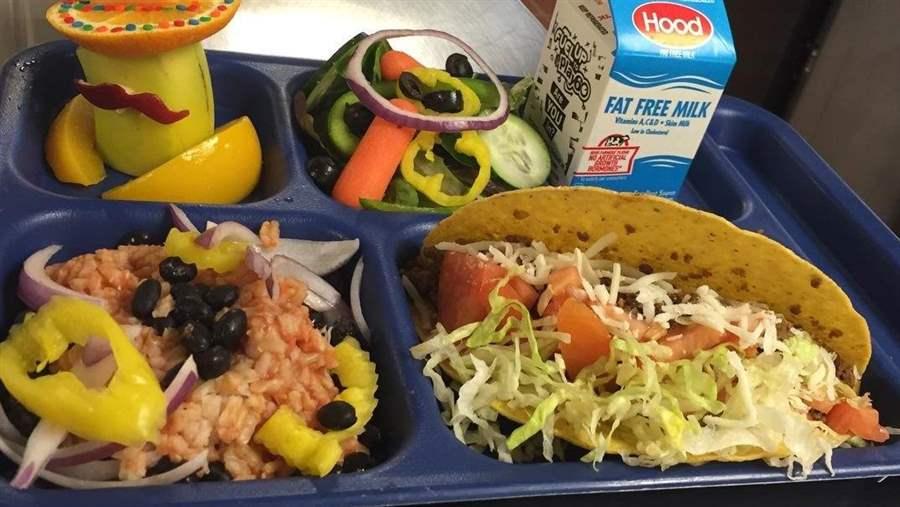Improving School Nutrition Goes Beyond the Cafeteria
Doris Demers is the director of school nutrition for the Oyster River Cooperative School District in Durham, New Hampshire, and vice president of the state’s School Nutrition Association. The Kids’ Safe and Healthful Foods Project talked with Demers about how she works with members of the community to improve school nutrition.
 © Oyster River Child Nutrition
© Oyster River Child NutritionA healthy favorite of Oyster River, New Hampshire, students: Taco Tuesday! Research shows that since the implementation of stronger nutrition standards, the availability of healthier items in public elementary school lunches has increased.
Q: How are students at your schools reacting to the healthier meals that meet today’s national nutrition standards?
A: Our meal participation is up across most of the district, in both breakfast and lunch. Oyster River recently won the New Hampshire School Breakfast Challenge by achieving a 69 percent increase in participation at our high school! We have very dedicated and creative managers who work hard to entice students to participate in school meals, and their efforts are paying off.
Even with this success, getting students to eat healthy is a work in progress. If kids aren’t eating veggies at home, they won’t want to eat them here. Our best veggie eaters are our elementary school students. They’re less apt to have habits that you have to struggle to change. If we start offering children healthy options when they’re in elementary school and then expand the choices into the upper grades as they move up, they’ll never notice a difference. Knowing what students like and how to present it is important. The school meal program is a restaurant within a school, and you need lots of skills to keep it going.
Q: You often visit other districts’ kitchens to get fresh ideas. What’s one of your biggest takeaways from a recent visit?
A: Every time I visit another district, I get a new idea for a better way of doing things. It’s the best way to see your program in a different light. Each director excels in something, and our profession is always happy to share successes.
One of the best ideas that I “stole” was from Pembroke. We had been cooking scratch entree recipes separately in all four schools, but at Pembroke I saw the benefits of centralizing some aspects of the program. We now produce all of the scratch entrees at one high school and deliver them to the other locations. This has helped us ensure consistent quality in these meals and give the other kitchens more time to prep time-consuming foods like farm fresh squash and other local favorites.
Q: In addition to your school nutrition peers, what other sources of help and support do you count on?
A: I’ve had nothing but positive encouragement from all the administrators and school board members from the time I accepted this position. They realize that their support helps our nutrition program attract more students and community involvement, and those successes have allowed us to improve our program’s financial stability and become less dependent on assistance from the district’s general fund.
We were also lucky to receive some USDA grant funding for a new convection oven at our middle school. Having the tools and equipment to do the job is an extremely important part of cooking real food. There are some complications to getting these tools though. It can be hard to get approval to replace antiquated equipment, so many districts are forced to repeatedly repair older equipment, which can end up costing more than a new oven, steamer, etc. We have worked hard over the last four years with our facilities department and our superintendent to be able to create a plan to replace or update all our failing equipment.
Q: Do you partner with members of the community outside your school network?
A: We are extremely lucky to be so close to the University of New Hampshire, and I have a great relationship with Nancy Johnson, who heads the dietetics program. We’ve had students come in and design menus such as the meals for our high school’s new taco bar. We feature it on Mondays and Tuesdays, and it has been extremely popular. This year a group of students created seasonal farm-to-school menus, which we plan to incorporate soon. If the foods are well received, they’ll become part of our regular rotation.
I also have an intern who is shadowing my kitchen managers and me this term. Next week, she’ll be helping students at our elementary schools taste test a fresh salmon dish we’re planning so that when we add it to the menu, the kids will feel confident it’s something they’ll like. I’m thrilled to be able to help dietetic students explore the world of child nutrition and the opportunities in school meal programs as they try to decide on their futures.
Q: What would you say to encourage someone who is considering a school nutrition career?
A: The most amazing thing about my 22 years in school nutrition is this: I have never had one day where I looked at the clock and thought, “Is that all it is?” Each day is different, a new adventure. There are so many things to keep your eye on that your time flies!
When you feed kids, you feel like you’re everyone’s mom or dad, and feeding them well is about as rewarding an experience as I could ever have. You meet people in your community and all over the country who become lifetime friends. When watching a football game, I think, “Oh, that’s Dora’s district,” or when watching a movie, I think, “Hey, that’s where Dayle lives.” Choosing this profession and being active in the School Nutrition Association has made me feel more connected to other places in the United States.











